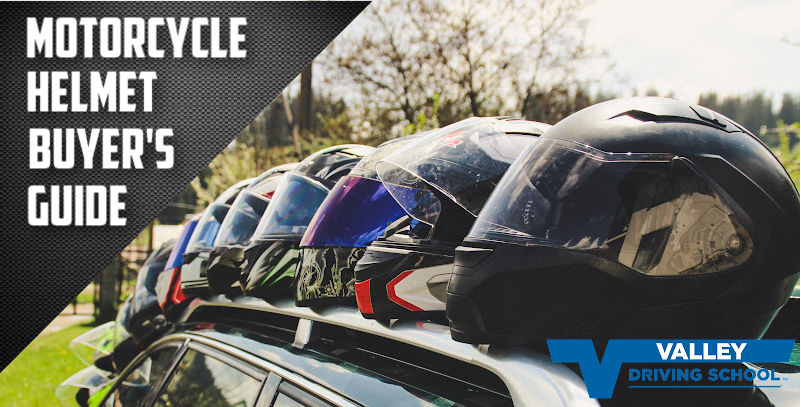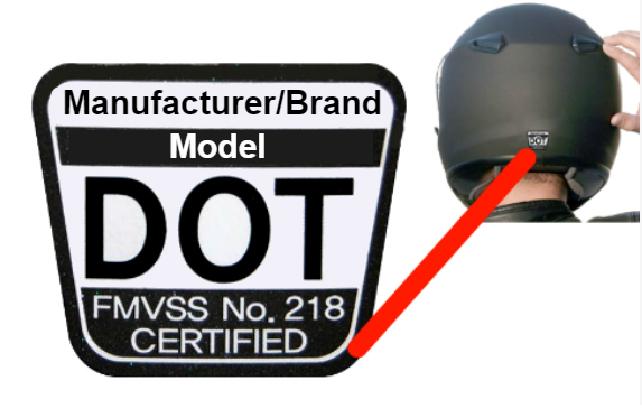There are few things that can rival the feeling of freedom and exhilaration manifested when riding a motorcycle, with the wind flowing over the body with the sounds of speed all around. The sensation is thrilling, but it also comes with certain compromises, particularly when it comes to personal safety. You should always give yourself the best odds with top quality safety gear, like a helmet that is properly constructed and fitted to you.

It can be overwhelming to figure out where to start with so many options available so we’ve compiled some key tips to help you make the best choice, as well as a helpful guide to proper sizing.
Safety Ratings
 One place to start the process of buying a proper helmet is with some research on the safety ratings. In Canada, provincial governments have the jurisdiction to pass and implement helmet laws. In British Columbia, motorcycle riders and passengers must wear a motorcycle safety helmet that meets one of the following safety standards, and the helmet must display the proper certifications:
One place to start the process of buying a proper helmet is with some research on the safety ratings. In Canada, provincial governments have the jurisdiction to pass and implement helmet laws. In British Columbia, motorcycle riders and passengers must wear a motorcycle safety helmet that meets one of the following safety standards, and the helmet must display the proper certifications:
DOT: conformance with the Federal Motor Vehicle Safety Standard No. 218; Motorcycle helmets (United States of America), also known as FMVSS 218 (49CFR571.218)
Snell M2005, M2010 or M2015: certification in accordance with the Snell Memorial Foundation 2005, 2010 or 2015 Standard for Protective Headgear for Use with Motorcycles and Other Motorized Vehicles
ECE: approved in accordance with the United Nations Economic Commission for Europe (ECE) Regulation No. 22
With three acceptable safety certifications, staying on the right side of the law is easy to do. Some motorcyclists will argue over which certification tops the other, and the general consensus seems to be that Snell and ECE are superior to DOT, and that ECE has a slight edge over Snell. However, all three certifications meet the requirements of safety and, in the case of an ICBC road test, all three will be accepted for the rider to wear.
Shape of the Helmet
Heads, like the rest of our bodies, come in different sizes, but also different shapes. Before figuring out the right helmet size, a rider should figure out the right helmet shape. The shape of a head will play a significant role in selecting a proper fitting motorcycle helmet. Manufacturers design their helmets to fit different head shapes which range across three primary designations. Long oval, which is shaped for a head that is longer front-to-back (from forehead to the back of the skull) than it is side-to-side (ear to ear). Intermediate oval, which is shaped for a head that is slightly longer front-to-back than it is side-to-side. Most motorcycle helmets will fall into this category as it is the most common head shape; if a helmet does not state its shape, this is usually it. Round oval, which is shaped for a head that has almost identical front-to-back and side-to-side measurements.
Once the head shape is determined, it is easier to filter available motorcycle helmets down to a smaller, more appropriate list of those which will fit the rider's head.
Helmet Size
Properly sizing a helmet can be a bit tricky. Unlike with a shirt or a pair of pants, even shoes, we don’t often think about head size in our daily life. The good news is that it isn’t that tough to figure out. It can be helpful to have a friend or family member on standby to provide a little assistance. Using a soft tape measure, like a tailor might use, measure the circumference of your head. You should place the tape above your eyebrows and around the back of your head. In a pinch, you can use a piece of string and lay it against a ruler after measuring to figure out the length. Once you have a measurement, you can compare your result against a helmet’s size chart to determine which size you need to order.
Helmet Fit
A new helmet should fit a little tight when it is first worn, but shouldn’t be so restrictive that it causes discomfort or pain. The interior of the helmet should come into contact with most of the head but if it puts pressure on specific points of the face or the skull, or if it moves around freely, then it doesn’t fit correctly. Like Goldilocks: not too big, not too small, juuuuuuust right! A helmet will adjust to the rider’s head shape over time and loosen a little but should never become loose enough to turn from side to side with ease.
Helmet Styles
 Motorcycle helmets come in different types, or styles, each offering certain benefits to address a rider's needs. Some riders like full all-around protection while others prefer a slim approach. There are three main types of helmets, and there are subcategories for each style. The three main styles are full face, open face, and half/beanies. Full face helmets are just as what they sound like, providing coverage that includes the entire face and chin. Most full face helmets will have a plastic visor that can be flipped up or remains in place. Open face helmets provide coverage over your forehead, and some will have the same plastic visor as the full face helmets. Open face helmets do not typically cover the mouth or chin. This style of helmet still covers the entire head, down to the neck on the back. Half/beanie style helmets offer the least coverage or protection, forgoing both the mouth/chin protection as well as the visor, and do not cover the entire back of the head.
Motorcycle helmets come in different types, or styles, each offering certain benefits to address a rider's needs. Some riders like full all-around protection while others prefer a slim approach. There are three main types of helmets, and there are subcategories for each style. The three main styles are full face, open face, and half/beanies. Full face helmets are just as what they sound like, providing coverage that includes the entire face and chin. Most full face helmets will have a plastic visor that can be flipped up or remains in place. Open face helmets provide coverage over your forehead, and some will have the same plastic visor as the full face helmets. Open face helmets do not typically cover the mouth or chin. This style of helmet still covers the entire head, down to the neck on the back. Half/beanie style helmets offer the least coverage or protection, forgoing both the mouth/chin protection as well as the visor, and do not cover the entire back of the head.
Here at Valley, we recommend full face as it provides optimal coverage and protection, but the style of helmet that riders wear comes down to personal preference and style.
Do Motorcycle Helmets Expire?
Consider replacing your helmet every 7 years after its production date (you can find a date stamp in the helmet, typically under the lining or padding) and after 5 years of use. If a helmet has been dropped or damaged, consider replacing as soon as possible even if damage is not visible. Cracks may be hard to see, but once the foam inside the helmet is cracked, crushed or damaged it is no longer able to protect your head as intended. If your helmet was involved in a crash where you hit your head a new helmet is definitely in order. Remember the helmet's job is to protect your head in a crash, and equipment that has been compromised in an accident cannot do its job properly and protect you.
–
A well-constructed and properly-fitted motorcycle helmet makes for a safer, more comfortable experience. If a helmet does not fit correctly it can cause pain and irritation, which can then lead to the rider being distracted and it may not completely protect the rider's head in a crash. If you spend time to find the helmet that fits and feels right, it will seem to almost disappear while wearing it. Be safe, smart, and ride with a correctly sized motorcycle helmet and enjoy the road for years to come!

